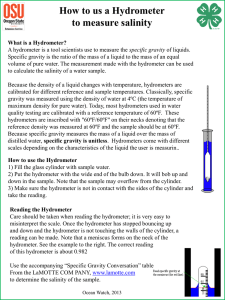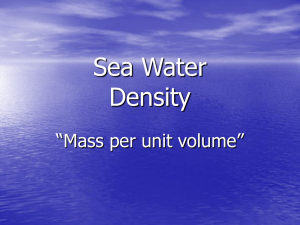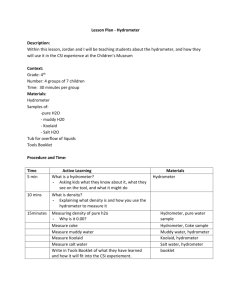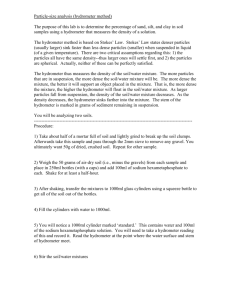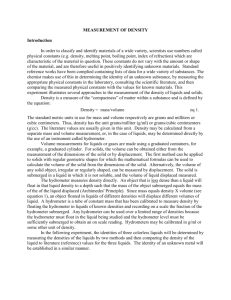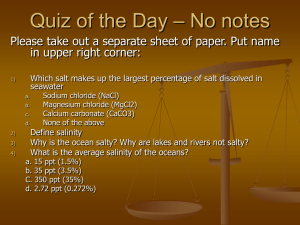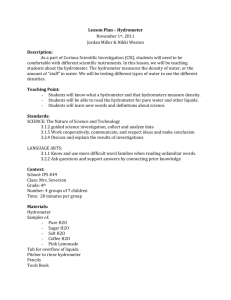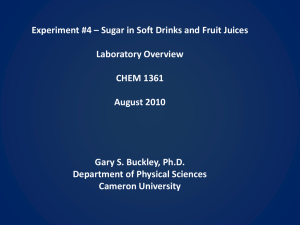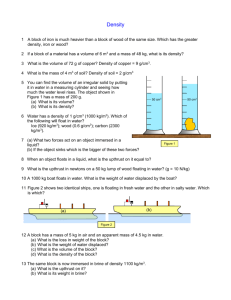Technical protocol
advertisement
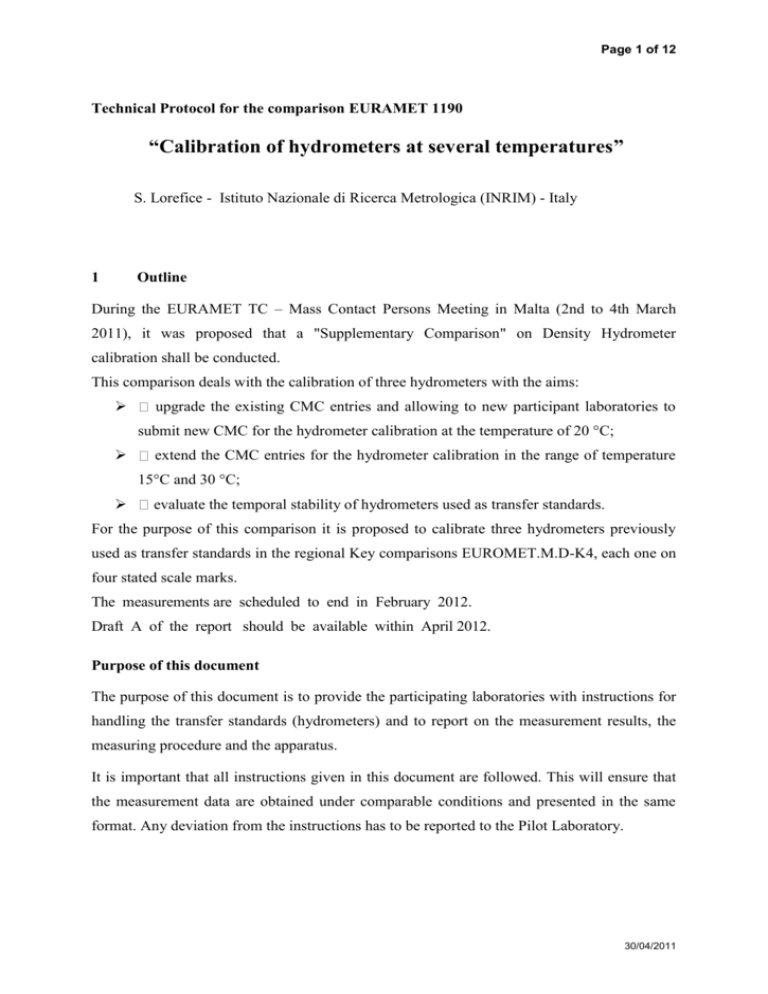
Page 1 of 12 Technical Protocol for the comparison EURAMET 1190 “Calibration of hydrometers at several temperatures” S. Lorefice - Istituto Nazionale di Ricerca Metrologica (INRIM) - Italy 1 Outline During the EURAMET TC – Mass Contact Persons Meeting in Malta (2nd to 4th March 2011), it was proposed that a "Supplementary Comparison" on Density Hydrometer calibration shall be conducted. This comparison deals with the calibration of three hydrometers with the aims: upgrade the existing CMC entries and allowing to new participant laboratories to submit new CMC for the hydrometer calibration at the temperature of 20 °C; extend the CMC entries for the hydrometer calibration in the range of temperature 15°C and 30 °C; evaluate the temporal stability of hydrometers used as transfer standards. For the purpose of this comparison it is proposed to calibrate three hydrometers previously used as transfer standards in the regional Key comparisons EUROMET.M.D-K4, each one on four stated scale marks. The measurements are scheduled to end in February 2012. Draft A of the report should be available within April 2012. Purpose of this document The purpose of this document is to provide the participating laboratories with instructions for handling the transfer standards (hydrometers) and to report on the measurement results, the measuring procedure and the apparatus. It is important that all instructions given in this document are followed. This will ensure that the measurement data are obtained under comparable conditions and presented in the same format. Any deviation from the instructions has to be reported to the Pilot Laboratory. 30/04/2011 Page 2 of 12 Transfer Standards as Artefacts (Hydrometer samples) For the comparison INRIM supplies three hydrometers in the density range 600 kg/m3 to 1300 kg/m3 to be used as transfer standards at 20 °C, 15 and 30 °C. Circulation of the Artefacts Each participating laboratory will send to the subsequent one the hydrometers as soon as calibrated, after that the laboratory, in accordance with the circulation scheme (Appendix B), and the pilot laboratory have been informed. The completion of the measurements and the date of dispatch, giving details of the transportation will be given by the form “Appendix C”.. Each set will be packed into a suitable container. The package will be transported by courier or directly by the personnel of the last laboratory. The package will be provided with a warning: To be opened only by laboratory personnel. After arrival of the package, the participating laboratories will inform the Pilot Laboratory without delay giving details of the arrival date, the state of the package and its contents (Appendix D). Each participating laboratory bears its own expenses for the transportation of the travelling set(s) to the next laboratory and any customs charges. The participants are responsible for completing the local customs formalities. Measurements At least 5 weighing-in-air sequences have to be carried out for the weight determination of each hydrometer and to evaluate the experimental standard deviation. The mean of the parameters contributing to the air density evaluation are to be recorded, i.e. pressure, temperature, relative humidity (or dew point), and CO2 content (whether measured or assumed). For the calculation of the air density, the revised CIPM formula (2007) is to be used [1]. The mean of this value is to be reported. 5.1 Mass measurement Mass least 5 weighing-in-air sequences have to be carried out for the weight determination of each hydrometer and to evaluate the experimental standard deviation. The mean of the parameters contributing to the air density evaluation are to be recorded, i.e. pressure measurements should be made under ambient laboratory conditions close to 20 °C. 30/04/2011 Page 3 of 12 Figure 1. Alignment of the stated scale reading with the horizontal plane of liquid. For the calculation of the air density, the revised CIPM formula (2007) is to be used [1]. The mean of this value is to be reported. 5.2 Hydrostatic weighing After the mass measurement, the hydrostatic weighing is to be performed without cleaning. The measurements should be made close to 20 °C, 15 °C and 30 °C. Note The measurements at 15 °C and 30 °C can be optional if the laboratory doesn’t will to submit its own CMC entries for these temperatures. The cubic expansion coefficient for all hydrometers is assumed to be 25·10-6 °C-1 with an uncertainty of 2·10-6 °C-1, rectangular distribution. At least 5 weighing sequences have to be carried out for the weight determination at each of the three scale readings stated and to evaluate the experimental standard deviation. Adjustment of the scale readings to the liquid level should be made when the middle of the line is aligned with the horizontal plane of liquid (Figure 1). The mean of the parameters contributing to the air density evaluation are to be recorded, i.e. pressure, temperature, relative humidity (or dew point), and CO2 content (measured or assumed). The mean value of the air density is to be reported. Reports As soon as the measurements are over, each laboratory will send the Pilot Laboratory a summary of the procedure used describing the apparatus, including, if possible, any reference, giving the mathematical model equations for calculating the corrections and how the standard uncertainties of the individual influence quantities are estimated. Besides, information and results should be made up using the enclosed MS Excel Report Form. 30/04/2011 Page 4 of 12 The MS Excel Report Form consists of two parts: 2.1 Report Form 1 It concerns information about the instrumentation used in the project. Please add any additional information obtained in your measurements. For the balance/s used to determine the weighing value in air/liquid, the following information is to be given: a) Manufacturer and type of balance, b) Maximum capacity, electronic range, resolution, c) Standard deviation, maximum non-linearity, out-of-centre error, d) Calibration uncertainty, method and frequency. If mass standards are used as "substitutional weight" for the comparison of mass of hydrometer to the mass of weights, the following information is to be given: a) Manufacturer, name and material of weights, b) Identification of weights, their masses and standard uncertainties (k=1), c) Date of last calibration and traceability. For the thermostat system used to stabilize the temperature of the buoyant liquid, the following information is to be given: a) Manufacturer and type of thermostat, b) Capacity, c) Temperature stability and uniformity at 20 °C, 15 °C and 30 °C. For the alignment system used for alignment the scale readings, the following information is to be given: a) Type of magnifier, b) Method of alignment, c) Uncertainty of alignment. For the instruments used for the determination of the density of air (air pressure, temperature, humidity and CO2 content), the following information is to be given: a) Manufacturer, type, b) Resolution, c) Frequency of measurement, d) Calibration uncertainty, date and traceability. For the instruments used for the measurement of the liquid temperature, the following information is to be given: 30/04/2011 Page 5 of 12 a) Manufacturer and type of sensor, b) Manufacturer and type of resistance bridge and standard resistor (if applicable), c) Resolution of temperature measurement, d) Calibration uncertainty, date and traceability of thermometer (whole temperature range). For the apparatus used for determining the surface tension of the buoyant liquid, the following information is to be given: a) Manufacturer and measuring method, b) Calibration uncertainty and traceability. For the reference buoyant liquid the following information is to be given: a) Manufacturer, b) product name, c) molecular formula and assay. 6.2 Report Form 2(ID Hydrometer) For each hydrometer, general information and results of measurements are to be given. General information is to be given in: Table 1-1: Movement of the travelling standard a) Date of arrival of the hydrometer at the laboratory, b) Condition of package and of the individual hydrometer, c) Date of shipment of hydrometers, d) Company responsible for transportation. Table 1-2: Measurement period a) Date for hydrometer mass measurement, b) Date for hydrostatic weighing. Measurement information is to be given in: Table 1-3: Mass determination a) Substitutional weights, if they are used, and mean value of the hydrometer mass for five weights in air and its standard deviation of the mean. b) Ambient conditions during mass measurements including data about air density, air temperature, air pressure, humidity and CO2 content. Table 1-4: Hydrostatic weighing 30/04/2011 Page 6 of 12 a) Mean value of the additional weight (ballast) if a stainless steel weight is added to the hydrometer to cause it to sink, and the standard deviation for the mean. b) Mean values of the hydrometer weighing value at the indicated scale reading. The standard deviation for the mean and the property of buoyant liquid during the hydrostatic weighing. c) Ambient conditions during hydrostatic weighing, including data about air density, air temperature, air pressure, humidity and CO2 content. Table 1-5: Results a) Corrections at each scale reading as determined at 20 °C, 15 °C and 30 °C. In the last column the reference surface tension is given. Table 1-6: Uncertainty budget for the hydrometer corrections A list of main components of the uncertainty budget is given. Please add any additional component occurring in your measurements. The uncertainty evaluation should include a list of all influence quantities, values, their degrees of freedom and their combined standard uncertainty. This is obtained by combining the individual standard uncertainties obtained from Type A and Type B evaluations, according to ISO "Guide to the Expression of Uncertainty in Measurement" [2]. A pooled experimental standard deviation characterizing the hydrometer weighing value in buoyant liquid is to be given [2 (H.3.6)]. Table 1-7: Uncertainty of the hydrometer corrections The uncertainty of measurement for the corrections is calculated here with the Excel sheet from the above given data, as well as the effective degrees of freedom eff of the combined standard uncertainty uc, the t-factor t95(eff) taken from the t-distribution for a 95% confidence level and the expanded uncertainty for the corrections as U95 = t95(eff) · uc . Deadline The reports are to be sent to the Pilot Laboratory as soon as possible but six weeks after the measurements are completed at the latest. A result will not be considered complete unless an associated uncertainty supported by a complete uncertainty budget is given. The results are confidential until all the participants have completed their measurements and all the results have been received (or until the deadline for receipt of results is over). 30/04/2011 Page 7 of 12 Special problem Please, do not hesitate to contact the Pilot Laboratory for any questions. 8.1 Breach of travelling standard In case a hydrometer is broken, its substitution will be decided at that time. 8.3 Late entry of a participant Due to the tight timetable, it is not possible for any additional participant to join after the circulation has started. Only if an additional comparison will be carried out due to breach of the hydrometer/s or due to unexpected delays might a late entry be possible. 9 [1] References A. Picard, R.S. Davies, M. Glaser, and K. Fujii : "Revised formula for the density of moist atr (CIPM 2007)," Metrologia, 2008, 45, pp. 149 - 155. [2] "Guide to the Expression of Uncertainty in Measurement," International Organization for Standardization (ISO), 1995. 30/04/2011 Page 8 of 12 Appendices A. Participants Country code Laboratory Istituto Nazionale di Ricerca Metrologica (INRiM) Strada delle Cacce, 91 -73 10135 Torino - ITALY Laboratoire National d'Essais (LNE) 1 rue Gaston Boissier 75724 Paris Cedex 15 - FRANCE Central Office of Measures - Glówny Urzad Miar (GUM) Physical Chemistry Department, Density, Viscosity and Spectral Analysis Laboratory, ul. Elektoralna 2 00-139 Warszawa - POLAND National Institute of Metrology (INM) Vitan Barzesti 11, 042122-Bucharest - ROMANIA Instituto Português da Qualidade (IPQ) Rua António Gião 2 2829-513 Caparica PORTUGAL National Institute for Standards (NIS), 136 Tersa St. El Haram, Giza, Egypt Contact Person IT Salvatore Lorefice S.Lorefice@inrim.it Tel: +39 011 3977 929 Fax: +39 011 3977 937 FR Paul-André Meury Paul-Andre.Meury@lne.fr Tel: +33 (0)1 40 43 38 86 Fax: +33 (0)1 40 43 37 37 PL Elżbieta Lenard, density@gum.gov.pl Tel :+ 48 22 581 9410 Fax :+ 48 22 581 9395 RO Gabriela Mares gabriela.mares@inm.ro Tel : +4021 3345060/ ext 109 Fax : +40213345345 PT Isabel Spohr ispohr@mail.ipq.pt Tel.: +35 1212948173 Fax: +35 1212948188 Alaaeldin A. Eltawil eltaweel38@yahoo.com Tel.: + 20 0100305355 B. Circulation scheme for the comparison Laboratory LNE INM IPQ GUM NIS INRIM Data May - June 2011 August - October 15, 2011 November 2011 December 2011 - January 2012 February 2012 – March 2012 April 2012 30/04/2011 Page 9 of 12 C. Fax/e-mail: Receipt of a comparison package To monitor the progress of the comparison, we ask on receipt of the package to kindly send a report by telefax to Salvatore Lorefice INRIM Strada delle Cacce, 91 - 73 10135 Torino ITALY Fax: +39 011 3919 937 e-mail: S.Lorefice@inrim.it This report should contain the following information: Participating laboratory Contact person Telephone Fax and a text like this: The package of the comparison EURAMET "Calibration of hydrometers at several temperatures” was received on (date). The package seems, after short inspection, (not) to be damaged. If damaged: (not) seriously. The contents is probably (not) suitable for use. Remarks: Date, signed 30/04/2011 Page 10 of 12 D. Fax/e-mail: Progress report To monitor the progress of the comparison, we ask to kindly send a report by fax/e-mail to Salvatore Lorefice INRIM Strada delle Cacce, 91 - 73 10135 Torino ITALY Fax: +39 011 3919 937 e-mail: S.Lorefice@inrim.it This report should contain the following information: Participating laboratory Contact person Telephone Fax and a text like this: Object: EURAMET "Calibration of hydrometers at several temperatures” The measurements were completed on (date). [The comparison package was shipped on (date) through the forwarding agency xx.] [The results were sent to the Pilot Laboratory on (date).] Remarks: Date, signed 30/04/2011
